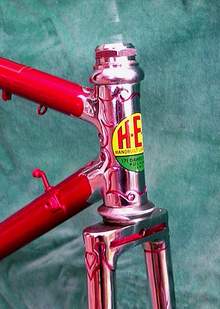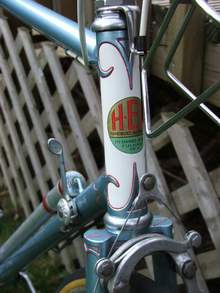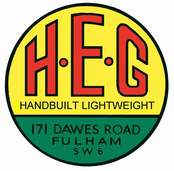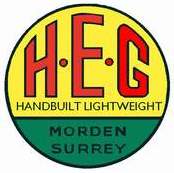Green, H E 'Doc'
Posted: Tuesday 02nd June 2020
According to his family, H. E. Green got the nickname Doc Green from being the first aider for the 29th Wheelers, long before the launch of ‘Dixon of Dock Green’ in 1955 and not the result of any clever word play.
Doc’s career as a frame builder began as a filer for Claud Butler after leaving the RNVR as a telegrapher during WWII. He progressed to become an apprentice frame builder at A.S.Gillott where he came into contact with a young Ron Cooper. Ron said he learnt a great deal from him in these formative years. But the immediate post war years were a boom for cycling and in 1948 ‘Doc’ felt confident enough to go it alone. In 1952 he opened a shop at 171 Dawes Road Fulham S.W.6. and started building frames in 1953. Later, in partnership with Harry Humphreys (a founder member of the Morden CRC), he opened a second shop at 8 Cinema Parade, Morden in South West London opposite the Underground station. As he and Harry Humphreys shared the same first initials, both premises were to become branches of H E Cycles.
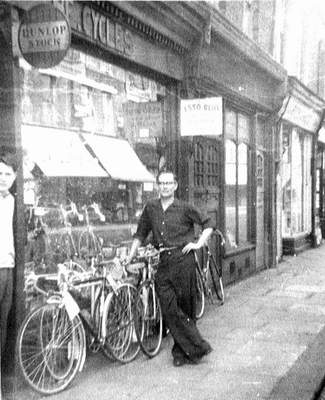
John Dodson who frequented Doc’s shop at Fulham in the days before this area and Chelsea were to change irrevocably in the ‘swinging sixties’ provides us with a flavour of the place in the mid 1950s.
“When I was a member of the Actonia Cycling Club in the mid 1950’s the bike of choice was a W.P.Newton. I, too, would have had a Newton but a cycling friend who had the enviable job of being the Saturday boy at H.E.Green’s Fulham shop (and owned an H.E.Green), persuaded me otherwise.
So, Doc Green made my first frame. Nervex professional lugs, 6” chrome forks and rear stays, painted in a magenta flam with gold lug lining. I think it cost £15 – (money saved from a morning paper round and a Saturday job pushing a trades bike for a wine merchant).
Frame building was done out the back in a room that connected the shop to the back yard. Whenever I called there after school, (which was as often as I could, especially when my frame was being built), Doc was happy for me, and I imagine other cyclists to wander out the back to talk to him while he was at work.
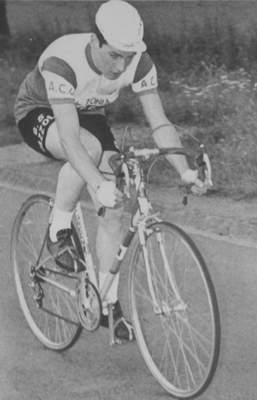
There used to be a dartboard on the back of the door which connected the shop to the workshop, and Doc always had a set of darts on the work bench. You’d say to him “double top Doc” and he’d stop whatever he was doing, pick up a dart and throw it at the board – double top!
(From Graham Lambert (Ex Actonia CC in the early sixties): Under the H E “Doc” Green section, you show an Actonia CC rider on one of Doc Green’s frames. Although I haven’t seen the rider or the frame for 46 years, I remember it well. The rider was Tony Bobbett and the photo was taken in 1962 by the club photographer, Bryan Gwyther. The frame was powder blue with chrome Prugnat long point lugs and 3/4 chrome forks and stays. Bit of a surprise to come across it in Australia, where I live, after all these years.)
Pete Russell was Doc Green’s assistant. He didn’t build frames but served behind the counter, did repairs and bike builds. I remember him leaving, sometime in the late 50’s, to open his own shop – Velo Sport in the Wandsworth Road near the Nine Elms shunting yards. Pete sold his own frames, badged Velo Sport. I wonder if Doc Green made them? Oh well, happy days!
According to John, Pete was also skilled in ‘butchering’ Brooks saddles, a process of customisation that was popular at the time but expensive. He later advertised these as special Velosport saddles in the Sporting Cyclist. The frame built for him by Doc in 1953 had an interesting paint job of dark gunmetal lustre that had a green head tube and a seat panel of ruby, white and green, with gold lug lining, which must have looked stunning.
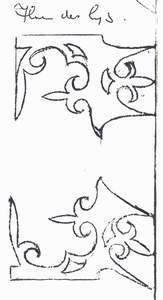
Doc offered eleven lug patterns (see Price List), from Nervex pro to hand cut lugs. There are also two reports of him building with customers‘ own hand-cut lugs. One belonged to Mike Barry, who left these shores to race in Canada and the USA in the 1960s and has owned a bike shop in Toronto for over thirty-five years. With its unique lugwork he spotted the bike again many years later on a visit to Europe. Doc also built for Algurn Lightweight Cycles in Garrett Lane, Wandsworth. According to Len Ingram who interviewed Doc around 2001, frames took up to 11 hours to produce and a seven day week was not unusual.
In 1953 a basic frame with Nervex lugs would cost £11-10s, with chrome £14-00s, and hand-cut spear points at £16-00. This included a two-colour paint job with lug lining. The most expensive frame, the ‘Fleur de Lys’ (see lug-drawing on right) cost £20 –00s and was not unlike the equivalent Gillott model of the same name but had many more cut-outs. Not surprisingly, it has been observed that there are a number of similarities with Gillott that included the frame numbering system, frame details and the design of the transfers although there was never a head badge.
However, a one-off special seen recently does have one cut from sheet brass. He built exclusively in Reynolds 531 butted tubing so there was often no need to add a tubing sticker. It is clear that he built a great many frames in ‘Nervex Pro’, which was the fashion at the time and by the early 1960s, an ‘Italia’ model using Prugnat lugs. (see photos)
From a personal point of view, I have owned an ‘Italia’ road/path for over 25 years, ridden mostly in ignorance of the builder but a valuable introduction to riding ‘fixed’ on the road. It was bought from Ray Young’s branch of Youngs Cycles in Trafalgar Road, Greenwich and I fell in love with the magenta over chrome paintwork. Youngs were famous for their Grandini frames built initially by Bill Philbrook.
It is clear from this model and one built in 1954, acquired by the writer more recently which has hand-cut lugs, that Doc liked to build with a steeper seat angle and shallow (72 deg) head coupled with a shortish fork rake. Although very different in size, design and BB height the ‘Italia’ has angles of 72 –74 and the one with hand–cut lugs 72-73 rather like a Frejus. The result is a peerless response and handling, justifying Ron Cooper’s description of him as a ‘master framebuilder’.
From the carbon copies in receipt books that survive from the early 1950s and the early 1960s (ones are missing from the late 50s) the number of frames built reflects the highs and lows of the lightweight cycle trade at that time. Whilst 78 frames were built in 1954 this declined to just 17 a decade later. Doc was forced to sell up in 1965 to start a new career with British Oxygen but remained a keen cyclist, gaining medals as a vet. He died in 2005.
Frame numbers start with 5301, the first two digits representing the year of build coupled with a sequential build number. This is normally found on the left rear fork end (dropout). The last recorded frame is 65655 and cost £18.0.0.
The head and seat transfers feature the letters H.E.G above ‘HANDBUILT LIGHTWEIGHT ‘ with the Dawes Road address in the section below. Frames purchased at Morden had simply MORDEN SURREY as the address. Down tube transfers were in an attractive script or as a block (see images below).
In pursuit of transfers and information about his H E Green frame VCC member Chris Hutchinson has provided me with new information about the marque from Morden CRC secretary, Graham Hutchings. Chris bought his bike secondhand from Rory O’Brien in 1973 and wanted to restore it and obtain the proper transfers. Like my own ‘Italia’ model, his frame had the number stamped under the bottom bracket and not on the left side of the rear dropout, the normal location on Doc Green frames.
Even more mysterious was that his frame number bore no relationship to mine or so we thought: mine being 13691 with Fulham transfers and his 71336, having transfers with the Morden address when he first bought it. However, it was felt that the dies and their position on the bottom bracket were identical and the build qualities were also similar. The mystery was solved when Graham wrote to Chris telling him that both were made by Bill Gray when he worked at the back of George Stratton’s shop in Battersea, seemingly after Doc gave up building frames in the mid 1960’s (see Len Ingrams report in N&V 287). The Fulham address on my bike suggests that Doc was complicit with this arrangement – but perhaps not.
Graham explained that a number of Morden CRC members still had their HEGs built by Bill. His own two frames stamped 69923 and 74723 were built in September 1969 and July 1974 respectively and therefore pointed to a date of March 1971 for Chris’s frame. One of Graham’s clubmates has a frame stamped 116682 which was built in February 1968 and obviously points to January 1969 as a date of build for my model. This came as a shock to us as we felt that both frames were built earlier. Bill must have changed his number configuration sometime before September that year. It also seems that the nylon headset that came with my frame was popular with elite time-trialists in the late 60’s and early 70’s. Graham thinks they were called ‘Nyflo’ and remembers fitting them at Harry Humphreys branch of HE Cycles when he worked there.
Steve Griffiths has identified these nylon headsets in the 1969 Bike Rider’s Aids catalogue. They were called ‘Nylfor’ and came in three colours: white, black and grey.
It was also the meeting place for Morden CRC on Fridays and Graham painted a vivid picture of the scene on Saturdays outside on the pavement where a strange mixture of bike fans and marriage parties would gather as the local Registry Office was situated above the shop. It finally closed when Cinema Parade was redeveloped and meant retirement for Harry, but we do not know exactly when (?late 1970s). According to Len Ingram’s report, Doc had sold his shop in Fulham in 1965 but did that shop continue to trade under his name? Doc’s daughters have been in touch with the website and it is hoped that further information will be forthcoming in due course.
Harry was able to provide Chris with the correct transfers for his frame from the few that remain in his possession and continues to be the president of the Morden CRC. I must thank Mike Barry for suggesting to me that I contact Graham for information some years ago and I am suitably red-faced for not doing so myself, but by passing it on to Chris much new information has come to light.
Bryan Clarke
November 2008
I would be particularly interested in receiving photographs and your memories of the Dawes Road and Morden shops and of course your ‘Doc’ Green frame. Please send them to me through the webmaster.
I lived in Morden as a child, and developed an interest in cycling at the beginning of the 1960’s when in my mid-teens. By chance, the shop on Cinema Parade was the nearest to my home and my visits to see Harry and Fred became more frequent (and I witnessed four or five weddings in the process). I developed immense respect for them both. Harry in particular was a man of great morality and full of sage advice: quite an original thinker.
I joined a cycling club in Kingston – some of my school friends were members – and by 1963 I was keen enough to want a respectable road racing bike. Harry, naturally enough, referred me to Doc. I cycled up to Fulham, full of excitement, and explained to Doc what I was after. We chatted about the general requirements, and he then measured me for the frame (elbow/wrist, knee/ankle etc). As a road race frame he suggested 73 degree parallel, front fork rake 2 3/8”, bottom bracket height 10½” etc.
I couldn’t afford Fleur de Lys, but I did go for the curly cut special lugs. With three-quarter A1 nickel chrome on forks and raer ends, brazings for CO2 pump and a down tube bottle cage, etc, and with the lugs picked out in a contrast colour and my name and club on the top tube the all-up price was £30.00. Having agreed all this Doc climbed back behind his desk, found a piece of paper and began drawing out the lug patterns. I watched him for a minute or two and then queried ’73 degrees parallel’?
Without a word Doc gave me the paper, a protractor and a dirty look. I felt I had to check the angle – and it was 73 degrees, drawn by eye. I left feeling sheepish and deflated, but with great admiration for his abilities, and with every confidence that I was purchasing the skills of a master craftsman.
The end product (frame number 63588) matched my expectation, I then had to fund the rest of it. A few parts I obtained second hand, but most came from Harry. One day after endless calculations I had worked out the gear ratios I wanted and went in to ask for the block and TA rings: 52 and 55 teeth. Can’t get a 55 teeth ring, said Harry: but there happened to be a rep in the shop. “Yes you can”, he said, and produced one; and I’ve still got it. I also added a B17 Swallow on a Campag seat pin: a stylish combination: (a similar replacement saddle I see advertised now at £499.99). My total bill, including the frame and two sets of wheels, general road plus a pair for racing – on large flange Record hubs – came to £83 odd. Nearly all of the parts were on credit: there was no written agreement, no schedule of payments, just a list of the items and prices on a piece of paper. Whenever I could pay a bit off, out came the list and the total was adjusted. There was never a time limit, or any request to hurry things up. It probably took me year to pay it off, with no interest charged. A man of honesty, integrity, and generosity of spirit.
When it arrived, it was/is a joy to ride. I raced as a Junior and 3rd Cat before going away to study. I didn’t take the bike, and my fitness level dropped. My parents moved to Devon (where we live now), so I lost contact with Harry and Fred. When married, the bike came with us to Vancouver for 12 years. Whilst there, it suffered smoke damage in a fire and had to be resprayed. The craftsmanship was much admired, but in the process it lost its HEG badge and the name on the down tube. Apart from that it remains much as it was when first assembled: though it could do with a good clean.
Posted: Tuesday 02nd June 2020
This article appears in the following categories.
Upcoming Events
Whether you are looking for a gentle social meet up, or a 100-mile ride browse the community’s upcoming events and plan your next weekend outing.

